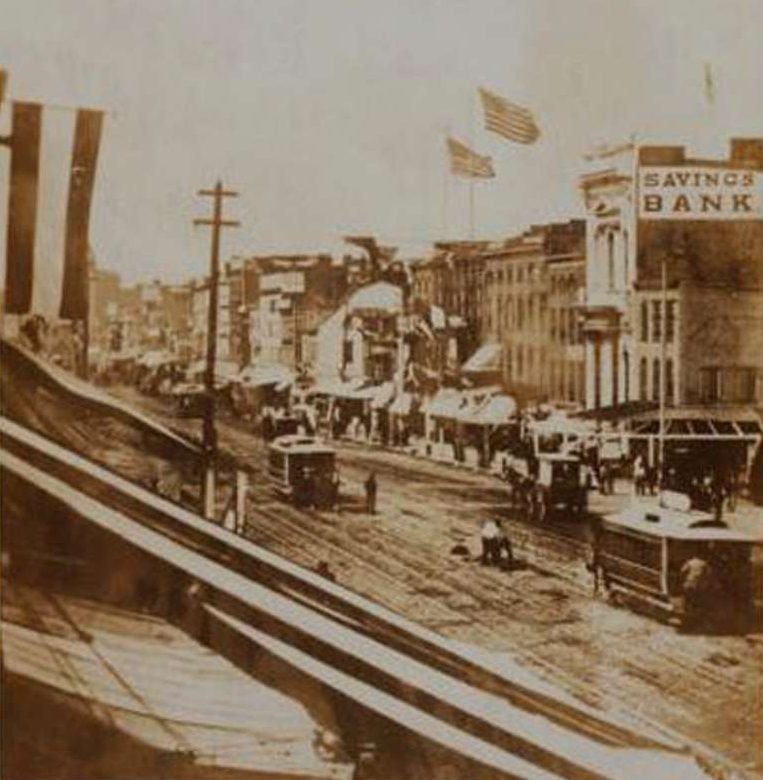
 The Bowery is one of Manhattan’s oldest “streets,” dating back to the Dutch days of New Amsterdam. It runs along the path Director-General Peter Stuyvesant took from his home at the tip of the island to his farm, which the Dutch called his bouwerij.
The Bowery is one of Manhattan’s oldest “streets,” dating back to the Dutch days of New Amsterdam. It runs along the path Director-General Peter Stuyvesant took from his home at the tip of the island to his farm, which the Dutch called his bouwerij.
In the 1870s, it ran about a mile from Printing House Square to 8th street. Printing House Square was the heart of the city’s newspaper business, where Park Row is today.
Back then, the Bowery was the place visitors to New York could see the patricians who cornered all the elegance, wealth, and condescension of the city rub elbows with the vermin who scraped crumbs out of the sewers. Silver spoons and filthy fingers alike dipped into its fleshpots.
It was definitely a cosmopolitan place. The rich Irish brogue and the sweet German accent dominated. But one also saw Black Americans, Spaniards, Portuguese, Italians, Frenchman, Mexicans, Asians and many others.

 One of the first “Heathen Chinee,” as Chinese (and other Asian people) were dubbed in the prejudices of the day, was Wah Kee. He operated a grocery and curio shop at the Bowery’s lower end. In 1872, he was one of 12 Chinese people living in the area.
One of the first “Heathen Chinee,” as Chinese (and other Asian people) were dubbed in the prejudices of the day, was Wah Kee. He operated a grocery and curio shop at the Bowery’s lower end. In 1872, he was one of 12 Chinese people living in the area.
Groceries and curios didn’t make him much money though. His serious profits came from his gambling operations and opium den on the second floor.
Word of his prosperity got back to the home country and a rival opened his own opium den. Others followed and by 1880, 700 Chinese people lived in the area. More kept coming, 10 to 15 thousand by 1910, and Chinatown was born.
Opium dens were only one sign of alleged depravity on the Bowery. As you headed up the street, you could find lots of gamblers leaning over pits, betting on dogs fighting, cocks too, and prize fights between men. One of the more popular of the pit sports was rat baiting.
Dogs were chasing rats, seeing how many they could kill in the shortest amount of time. Entry to a pit could run as high as five bucks if good dogs were chasing a lot of rats. One enterprising pit owner offered a hundred dollar purse to the most vicious terrier of the evening, double if he killed a hundred rats in a quarter hour.

 Heading further north, you would pass several theaters, of which the Old Bowery Theater was one of the most notorious. Like Wall Street though a lot less respectable, these theaters were male worlds. If a fellow wanted to watch the show, he had best take a seat in one of the first two tiers.
Heading further north, you would pass several theaters, of which the Old Bowery Theater was one of the most notorious. Like Wall Street though a lot less respectable, these theaters were male worlds. If a fellow wanted to watch the show, he had best take a seat in one of the first two tiers.
The upper tier of Bowery theaters was where prostitutes plied their trade. One writer said you could view more depravity and degradation in the gallery of a Bowery theater than anywhere else in the city.
Back on the street, next door to the Old Bowery you would find the Atlantic Garden, one of many German beer halls, seating a thousand. The beer halls were respectable places where extended families would head on Sundays to spend the day drinking large mugs of beer at a nickel apiece, listening to music and dancing, playing cards or dominos, billiards or bowling.
All that was illegal – no establishments were allowed to serve beer on Sunday. But as one congressional candidate in the largely German 8th District said, “Just as the religious American has the privilege of going to his church, so must the Germans have the right to seek their recreation on Sunday, specifically to drink your glass of lager beer in peace and quietness so long as you do not disturb the public order.”

 Further up at the corner of Prince Street, you found one of the most respectable places on the Bowery: Tony Pastor’s Opera House. This was the impresario’s first theater. As an innovative entrepreneur, he aimed for a broad respectable audience, if not the fashionable set
Further up at the corner of Prince Street, you found one of the most respectable places on the Bowery: Tony Pastor’s Opera House. This was the impresario’s first theater. As an innovative entrepreneur, he aimed for a broad respectable audience, if not the fashionable set
attending performances on Broadway.
He announced his place as a beautiful Temple of Amusement, The Great Family Resort of the City, where heads of families can bring their ladies and children to witness unexceptionable entertainment that will please the most fastidious.
If you’d had enough of the Bowery after you went a few blocks further north, you could escape left onto Bleecker Street and enter New York’s Little Bohemia.
Illustrations, from above: The Bowery Looking North from Houston Street, 1870 (NYPL); A Rat Pit on the Bowery (source unknown); Inside the Bowery Theater (Library of Congress); and Tony Pastor’s Opera House (Metropolitan Museum of Art).

